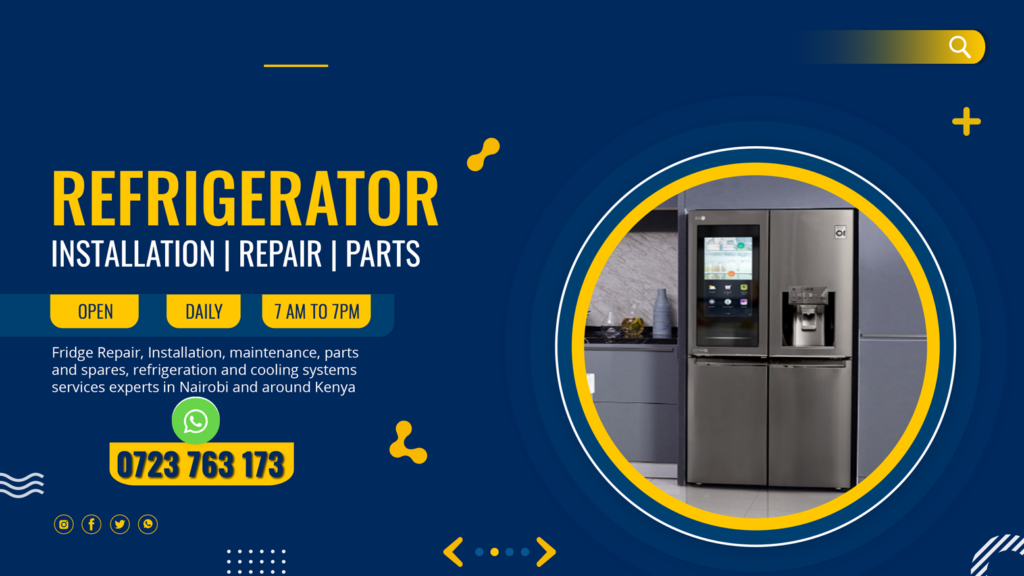Excellent Fridge Repair in Nairobi, Kenya
Are You Looking for Refrigerator Repair Services “Near Me” or Refrigerator Repair “In Nairobi“? Get the best #1 Fridge Repair Services in Nairobi and Kenya. Fridge Repair-KE is a top provider of reliable Refrigerator repair needs in Nairobi and allover Kenya. Our expert technicians specialize in diagnosing and fixing a wide array of refrigerator issues, ensuring efficient and lasting solutions. Whether it’s a domestic fridge, commercial fridge, or specialized units like beer and wine chillers, we offer professional repairs using genuine parts and industry best practices. Count on us for quality service, and a commitment to restoring your fridge’s functionality instantly.

Fridge Repair in Nairobi for All Refrigerator Types
When your are looking for technicians to render the best Fridge Repair in Nairobi, Freezer Repair in Kenya, Cold room installation services, Refrigerator Service, Air conditioner repair, Ventilation systems installation, and cooling systems services, its best to work with professionals for optimal results.
Choose to Work With Fridge Repair Professionals
When your are looking for technicians to render the best Fridge Repair in Nairobi, Freezer Repair in Kenya, Cold room installation services, Refrigerator Service, Air conditioner repair, Ventilation systems installation, and cooling systems services, its best to work with professionals for optimal results.
Fridge Spare Parts
- Fridge Fan Motors, Ice Makers
- Light Bulbs, Temperature Sensors
- Fridge Water Dispenser
- Fridge Drain Pans
- Fridge Doors
- Refrigerator Shelves


Beer Chiller Repair in Nairobi
Beer chillers, also known as beer coolers or kegerators, are appliances designed to keep beer at the optimal serving temperature. They come in various sizes and designs, from small countertop units to larger freestanding ones used in bars and restaurants.
“Reliable Fridge Repair Services in Nairobi”

Judy Bolo
Nairobi
FRIDGE GAS REFILL / REFRIGERANT RELOADING IN NAIROBI & KENYA
Fridge Repair Kenya, a leading service provider in Nairobi, offers comprehensive fridge refrigerant refilling services, catering to a diverse range of refrigeration systems. Their specialized expertise involves meticulous assessment of refrigerant levels, identifying leaks or deficiencies, and executing precise refilling procedures with high-quality refrigerants. Employing skilled technicians equipped with modern diagnostic tools and adhering to industry standards, Fridge Repair Kenya ensures efficient, reliable, and environmentally conscious refrigerant refills for various fridge models, ensuring optimal cooling performance and extending the lifespan of refrigeration units across Nairobi.
Fridge Spares and Parts in Nairobi, Kenya

Fridge Repair Kenya Updates
-
Why Is My Refrigerator Overcooling or Freezing Food?
A refrigerator that overcools or freezes food in the fresh food compartment can lead to spoiled produce and wasted resources,
-
Can Power Surges Damage My Refrigerator’s Components?
Power surges, a common occurrence in Kenya due to unstable electrical grids, can pose a significant threat to refrigerator components,
-
How Much Does It Cost to Repair a Refrigerator Compressor?
The compressor is a critical component of a refrigerator, responsible for circulating refrigerant to maintain cooling, making it essential for
-
What Should I Do If My Refrigerator Smells Bad?
A bad-smelling refrigerator can be a significant inconvenience for households and businesses in Kenya, affecting food quality and kitchen hygiene.
-
Why Is My Fridge Water Dispenser Not Working?
A malfunctioning water dispenser in a refrigerator can disrupt access to clean drinking water, a significant inconvenience for households and
-
Orchid Valley Fridge Repair Services
Orchid Valley Fridge Repair Services, offered by FridgeRepairKenya.com (FRK), provide essential solutions for residents and businesses in Orchid Valley ,
-
Hawk Eye Villas Fridge Repair Services
Hawk Eye Villas Fridge Repair Services, offered by FridgeRepairKenya.com (FRK), provide essential solutions for residents and businesses in Hawk Eye
-
How Can I Fix a Clogged Defrost Drain in My Refrigerator?
A clogged defrost drain in a refrigerator can lead to water pooling inside the appliance or leaking onto the floor,
-
Convent Drive Fridge Repair Services
Convent Drive Fridge Repair Services, offered by FridgeRepairKenya.com (FRK), provide essential solutions for residents and businesses in Convent Drive ,
FULL LIST OF FRIDGE, FREEZER, COLDROOM, AND REFRIGERATOR SERVICES
[pt_view id=”279539e39i”]Call Now For Inquiries
Call To Inquire about Fridge Repair Services
